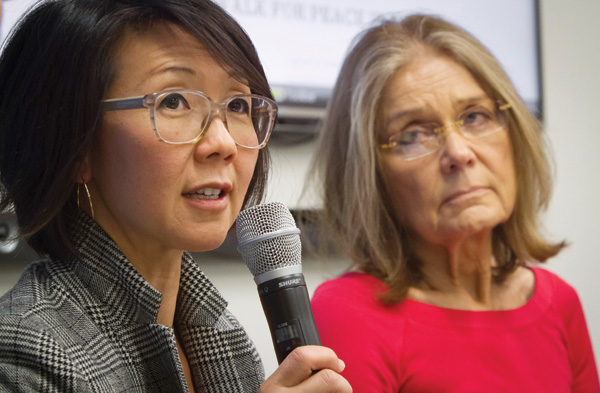Pictured above: Christine Ahn, shown here with Gloria Steinem, at a United Nations news conference on March 11 announcing plans for a walk across the DMZ. (Photo courtesy of AP Photo/Bebeto Matthews)
by SUEVON LEE | @suevlee
editor@charactermedia.com
Shortly after Christine Ahn, co-founder of Women De-Militarize the Zone and a former policy and research analyst with the Global Fund for Women, publicly announced plans for a Women’s Walk for Peace in Korea, KoreAm spoke with the organizer by phone to glean further details about the inspiration behind the planned walk.
The conversation has been edited for length and clarity.
What are the goals of this walk across the DMZ?
Christine Ahn: To end the war with a peace treaty, to urge leaders of the two Koreas to immediately begin family reunification and to ensure that women are involved in all levels of the peace-building process.
What inspired the idea?
The idea started in 2009. I woke up in the middle of the night and was unable to go back to the sleep. [I began reading an article] about the flooding of the Imjin River which flows from North to South. [The floodwaters] would have been devastating to [North Koreans’] farmland. They allegedly lifted the floodgates without informing South Korea. Kim Jong-il and [then South Korean president] Lee Myung-bak were so angry and couldn’t pick up the phone and communicate. Six [South Koreans] died.
I went to sleep. I had a dream where I was wading in the river. I was situated in South Korea. It was before dawn, and at sunbreak, there was a glow of light flowing down the river and that light morphed into unification. It was beautiful and moving and powerful and yet I wanted to keep going up the river to see where the source of the light was coming from. When I came to the source, I was really moved and surprised: It was a circle of women and they were basically stirring a big, black kettle. Whatever they were stirring was poured into little pails that flowed down the river that became a light.
What have you observed regarding the differences between the two Koreas?
On the South Korean side, it felt so Disneyland-ish. In South Korea, I think in many ways they’ve moved on. Certainly there are millions of families that are still divided and those that yearn for Korean unification, but they’re in this high fast-paced society. When I was on the North side, it felt really sad to me for some reason. We’re obviously always going to get two sides of the story. For the North Korean people, there really is a deep longing for reunification.
How did Gloria Steinem come to be involved?
I’ve been lucky to be friends with her. She was the first person I called to see if international women are able to do this. She immediately replied and said yes, she has classmates who were drafted in the Korean War and that she will do whatever she can to help with the healing. She can open lots of doors, and she’s been just instrumental and dedicated.
What kind of response has your idea generated?
People are really excited, and I think there’s tremendous goodwill, from my family in South Korea to renowned human rights activists and academics. South Korea is abuzz with men and women, old and young, who are just so happy there is some kind of movement to break the impasse. The overwhelming, enthusiastic response has been so heartening.
Female activists plan to walk across the DMZ between the two Koreas on May 24, International Women’s Day for Peace and Disarmament.
Recommended Reading
“Women’s Group Gets North Korea’s Approval to Walk Across DMZ”
“Gloria Steinem Joins Female Activists in North Korea for DMZ Peace March”
___









